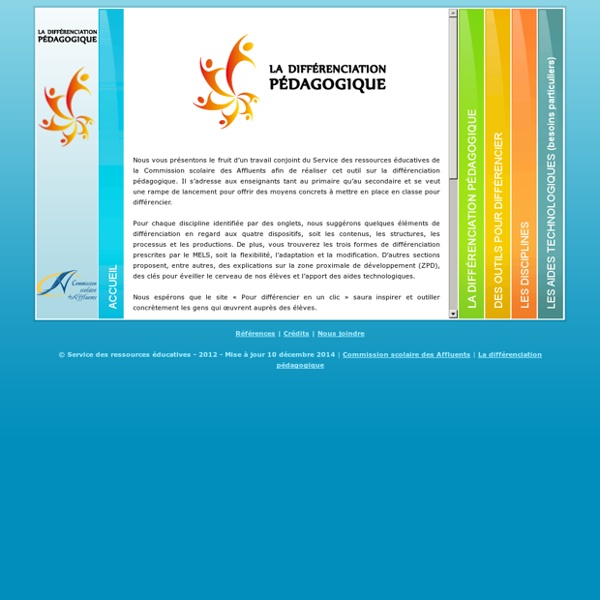



Hazelwood School GM + AD Architects pursued the Hazelwood project with a commitment to building knowledge and capacity on a building that would work with children with a very complex range of abilities. Most extant examples are schools serving the needs of children with visual limitations, or hearing limitations, or cognitive issues or physical limitations. In this case, the design would need to meet the needs and enhance the independence of children with a mix of all of these issues.
De la Différenciation Pédagogique à la Personnalisation des apprentissages Your report has been submitted. There was a problem submitting your report. Please contact Adobe Support. Report Abuse If you feel that this video content violates the Adobe Terms of Use, you may report this content by filling out this quick form. What Does Personalized Learning Mean? Whatever People Want It To —Getty For some, such variety is reason for optimism. But others warn that loose definitions could lead to incoherence and ineffectiveness Personalized learning has a big problem. Inside America's schools, the term is used to mean just about anything. Physics Flash Animations We have been increasingly using Flash animations for illustrating Physics content. This page provides access to those animations which may be of general interest. The animations will appear in a separate window. The animations are sorted by category, and the file size of each animation is included in the listing.
Blog How to Use Technology in the Classroom - MentorMob Blog Everyone seems to think that technology can help students, parents, and teachers solve the host of challenges facing education today. But how exactly tech should be integrated into existing lesson plans, what kind of web access kids should have in school, and how new hardware gets paid for are just a few of the barriers to change. But there are two particular models for tech integration that seem promising: Flipped Classroom and Project Based Learning. The critical questions these two teaching methods ask are these: how can classroom learning facilitate a collaborative atmosphere that’s engaging for students and that mimics the 21st century work environment? And how can the same technology that students often use at home be leveraged to foster teamwork and critical thinking in the classroom?
Best Practices in Educational Facilities Investments Exemplary design categories: multi-sensory environment, outdoor spaces, safety, special needs provision How the facility meets the needs of education and communities: The ambition of this school for children and young people with sensory impairments was to create a challenging and stimulating environment for all. Varied wall and floor surface textures and built-in navigational aids - such as trail rails, varied ceiling heights, and the print, Braille, moon and graphical signage - help children to navigate around the building independently. The main school building is a single-storey “s” shape structure that reduces the perceived scale of the school and makes it less intimidating and more welcoming to small children.
Response: Differentiation Lets Us Reach Our Students 'Where They Are' - Classroom Q&A With Larry Ferlazzo (This is the last post in a two-part series. You can see Part One here.) This week's question comes from an educator who wishes to remain anonymous: Here’s What Happens When Every Student Gets a Personalized Learning Plan High school sophomore Olivia Surdam thought she wanted to have a career in healthcare as a doctor or nurse, but after recognizing that her sensitive stomach would cause barriers for a career path in patient care, Surdam started considering other options with her advisory teacher. Reflecting on some fond memories of her father teaching her to use a hammer and screw gun to build structures as a young child, she was inspired to research opportunities that would allow her to recreate that experience. She attended an event called “Women Can Do,” where one of the projects was to construct a bridge using toothpicks and marshmallows. The activity was a crystallizing moment for Surdam, setting her on a new path. She has since altered her personalized learning plan (PLP) to include the courses and experiences she’ll need to pursue a career in architectural engineering. Legislation Leads Change